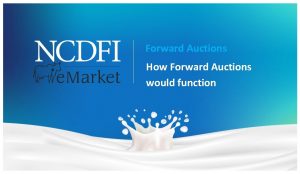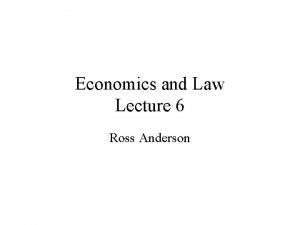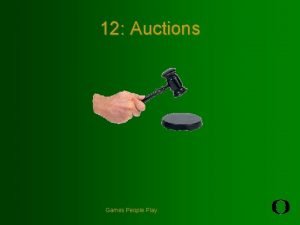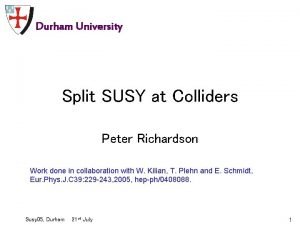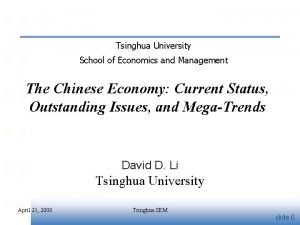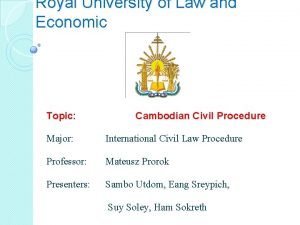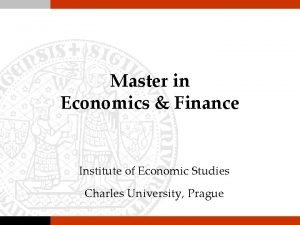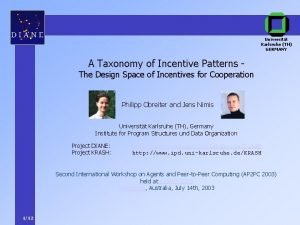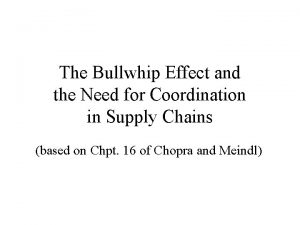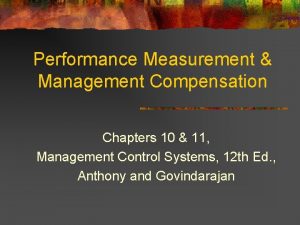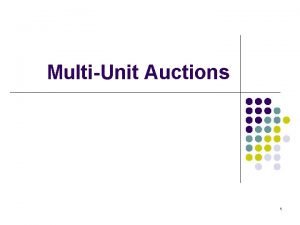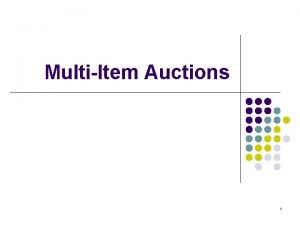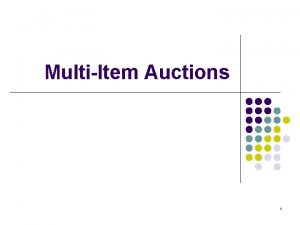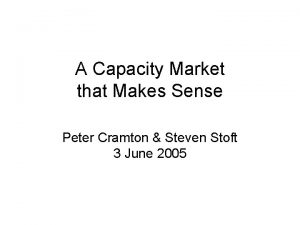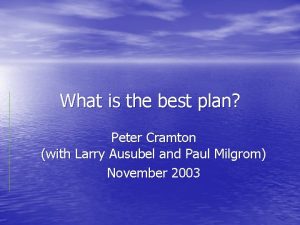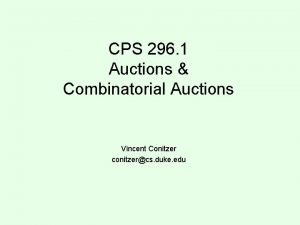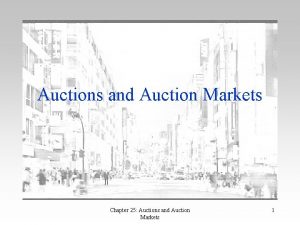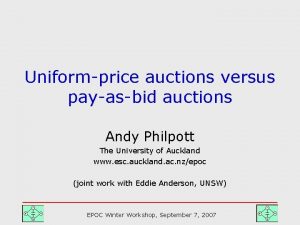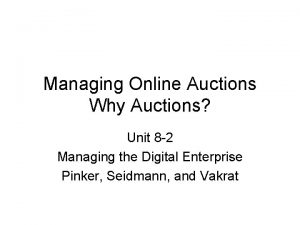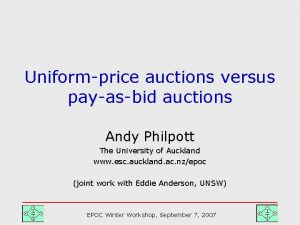Incentive Auctions Peter Cramton Professor of Economics University



































- Slides: 35

Incentive Auctions Peter Cramton* Professor of Economics, University of Maryland Chairman, Market Design Inc. 23 May 2011 (updated 29 May 2011) * Special thanks to Larry Ausubel, Evan Kwerel, and Paul Milgrom for collaborating with me on this topic over the last dozen years. Thanks to the National Science Foundation for funding. 1

Incentive auctions Low value High value Over-the-air TV broadcast Mobile broadband Auction includes essential regulatory steps to address market failures in the secondary market for spectrum 2

Letter from 112 economists, 6 April 2011 3

Motivation Value per MHz sm Explo art ph sion i on es n use and of tab let s Value of mobile broadband Value of over-the-air broadcast TV TV s igna l rec and eived sate via c able llite 1985 1990 1995 2000 2005 2010 2015 Year Gains from trade 4

VHF and UHF bands Current uses (TV broadcast) Lower VHF Upper VHF UHF RA Public Safety TV ch 14 -36 698 TV ch 7 -13 614 608 512 470 216 174 88 54 TV ch 2 -6 37 TV ch 38 -51 Possible future uses Lower VHF Upper VHF UHF 37 Flexible Use 698 614 608 TV ch 7 -13 512 470 216 174 88 54 TV ch 2 -6 RA Flex. Use Public Safety TV ch 14 -? ? 5

Voluntary approach Share with another For simplicity, I assume that channel sharing is only 2: 1; other possibilities could also be considered, including negotiated shares with particular partners announced at qualification ir e-a r-th ove ast ase roadc b Ce Con tin air ue ov bro eradc the ast - TV broadcaster freely decides to Spectrum freed 0 MHz 3 MHz 6

Why voluntary? • More likely to quickly clear spectrum – Broadcasters benefit from cooperating • Lower economic cost of clearing – Spectrum given up only by broadcasters who put smallest value on over-the-air signal • Market pricing for clearing – Avoids costly administrative process • Efficient clearing – Clear only when value to mobile operator > value to TV broadcaster 7

Two approaches Too complex due to repacking Combinatorial exchange Reverse auction to determin e supply Optimization gives mandatory repacking options Forward auction to determine demand Market clearing and settlement 8

Share with another Con ir e-a r-th ove ast ase roadc b Ce tin air ue ov bro eradc the ast - TV broadcaster freely decides to Reverse auction to determine supply Spectrum freed 0 MHz 3 MHz 6 MHz • Mostly single channel • Price discovery less important => • Sealed-bid auction or descending clock – Price to cease – Price to share 9

Washington DC 0 MHz P = $30 7 Reverse auction to determine supply S = 48 3 MHz 6 MHz Price = $30/MHz. Pop 9 31 18 37 47 44 13 26 22 41 35 10

Washington DC 0 MHz P = $20 7 Reverse auction to determine supply S = 36 3 MHz 6 MHz Price = $20/MHz. Pop 9 31 18 37 47 44 13 26 22 41 35 11

Washington DC 0 MHz P = $10 7 Reverse auction to determine supply S = 24 3 MHz 6 MHz Price = $10/MHz. Pop 9 31 18 37 47 44 13 26 22 41 35 12

P = $20 S = 36 7 13 9 26 22 31 18 41 37 47 44 35 Mandator y repacking Supply = 160 MHz 5 11 13 15 7 9 13 15 13

• Mobile operators want large blocks of contiguous paired spectrum for LTE (4 G) – One to four 2 × 5 MHz lots Forward auction to determine demand • Complementaries strong both within and across regions • Package clock auction ideal – Within region complementarities guaranteed with generic lots – Across region complementarities achieved through optimization of specific assignments 14

Package clock auction: Overview • Auctioneer names prices; bidder names package – Price increased if there is excess demand – Process repeated until no excess demand • Supplementary bids – Improve clock bids – Bid on other relevant packages • Optimization to determine assignment/prices • No exposure problem (package auction) • Second pricing to encourage truthful bidding • Activity rule to promote price discovery 15

Price P 6 Supply P 5 Forward auction to determine demand P 4 P 3 P 2 P 1 P 0 Demand Quantity 16

Price Forward auction to determine demand Supply P* Demand Q* Quantity 17

Price Forward auction to determine demand Supply PD To Treasury PS Broadcasters cannot negotiate ex post with operators, since it is the FCC’s repacking that creates value; ex post trades would not benefit from repacking To TV broadcasters Q 0 Q* Demand Quantity 18

Ways Congress can screw up • Impose restrictions on which broadcasters can participate in the auction – Destroys competition in reverse auction • Make repacking purely voluntary – Reverses status quo—FCC can relocate stations – Creates holdout problem in reverse auction • Too greedy – Impose specific requirement on government revenue share (e. g. , Treasury gets 40% of revenue) 19

Price Not too greedy: Quantity choice left to FCC Supply PD PS To Treasury Demand To TV broadcasters Q 0 Q* Quantity 20

Price Too greedy constraint: Treasury must get at least 40% Revenue share constraint causes huge social welfare loss and reduces Treasury revenues! Supply PD To Treasury Demand PS To TV broadcasters Q 40% Q* Quantity 21

Ways FCC can screw up • Impose restrictions on which broadcasters can participate in the auction – Destroys competition in reverse auction • Make repacking purely voluntary – Reverses status quo—FCC can relocate stations – Creates holdout problem in reverse auction • Adopt poor auction design • Fail to address competition concerns 22

Background Package Clock Auction 23

Package clock auction: Overview • A package bid is an all-or-nothing bid for a portfolio of products • When bidding on individual lots, a bidder is exposed to the risk of winning only some of a complementary set of products • Package bidding eliminates the exposure problem by allowing bidders to bid on packages of products • At the same time, package bidding can help to alleviate the demand reduction problem in which larger bidders inefficiently reduce demand in order to win spectrum at lower prices 24

Package clock auction: Overview • Auctioneer names prices; bidder names package – Price increased if there is excess demand – Process repeated until no excess demand • Supplementary bids – Improve clock bids – Bid on other relevant packages • Optimization to determine assignment/prices • No exposure problem (package auction) • Second pricing to encourage truthful bidding • Activity rule to promote price discovery 25

Package clock auction adopted for several recent and upcoming auctions • UK 10 -40 GHz spectrum – February 2008, 27 rounds, £ 16 million • UK L-band spectrum – May 2008, 33 rounds, £ 8. 3 million • UK 800 MHz and 2. 6 GHz – First-quarter 2012 • Netherlands 2. 6 GHz spectrum • Belgium 2. 6 GHz spectrum • Austria 2. 6 GHz spectrum 26

Bidder-optimal core pricing • Minimize payments subject to core constraints • Core = assignment and payments such that – Efficient: Value maximizing assignment – Unblocked: No subset of bidders offered seller a better deal 27

Five-bidder example with bids on {A, B} • • • b 1{A} = 28 b 2{B} = 20 b 3{AB} = 32 b 4{A} = 14 b 5{B} = 12 Winners Vickrey prices: p 1= 14 p 2= 12 28

The Core Bidder 2 Payment b 4{A} = 14 b 1{A} = 28 b 3{AB} = 32 Efficient outcome b 2{B} = 20 20 The Core 12 b 5{B} = 12 14 28 32 Bidder 1 Payment 29

Vickrey prices: How much can each winner’s bid be reduced (while holding others fixed)? Bidder 2 Payment b 4{A} = 14 b 1{A} = 28 b 3{AB} = 32 b 2{B} = 20 20 The Core 12 Vickrey prices b 5{B} = 12 Problem: Bidder 3 can offer seller more (32 > 26)! 14 28 32 Bidder 1 Payment 30

Bidder-optimal core prices: Jointly reduce winning bids as much as possible (while remaining within core) Bidder 2 Payment b 4{A} = 14 b 1{A} = 28 b 3{AB} = 32 b 2{B} = 20 20 al im pt r-o de d Bi The Core re co 12 Vickrey prices b 5{B} = 12 Problem: bidderoptimal core prices are not unique! 14 28 32 Bidder 1 Payment 31

Core point closest to Vickrey prices (Alternative: core point closest to linear prices) Bidder 2 Payment b 4{A} = 14 b 1{A} = 28 b 3{AB} = 32 b 2{B} = 20 20 Unique core prices 15 12 Vickrey prices b 5{B} = 12 Each pays equal share above Vickrey 14 17 28 32 Bidder 1 Payment 32

Package clock auctions: Activity rule • Activity rule based on revealed preference: Bidders can only move toward packages that become better values – At time t > t, package qt has become relatively cheaper than qt (P ) qt (pt – pt) – Supplementary bid b(q) must be less profitable than revised package bid at t (S ) b(q) b(qt) + (q – qt) pt 33

Properties with substitutes • Bidding on most profitable package is best • Clock yields competitive equilibrium with efficient assignment and supporting prices • Final assignment = clock assignment 34

Properties in general • Supplementary bids needed if excess supply • Bidder can guarantee winning its final package by raising bid by final price of unsold lots 35
 Maastricht university economics and business economics
Maastricht university economics and business economics Promotion from associate professor to professor
Promotion from associate professor to professor Christys angels auctions
Christys angels auctions Type of auctions
Type of auctions Baystate auctions
Baystate auctions Ross sinclaire
Ross sinclaire Regretnet
Regretnet Ecommerce online auctions
Ecommerce online auctions Forward auctions
Forward auctions Anderson auctions
Anderson auctions Play auctions
Play auctions Professor hans peter dietz
Professor hans peter dietz Professor peter richardson
Professor peter richardson Mathematical vs non mathematical economics
Mathematical vs non mathematical economics Seattle university economics
Seattle university economics University of waterloo departments
University of waterloo departments Faculty of business and economics mendel university in brno
Faculty of business and economics mendel university in brno Tsinghua school of economics and management
Tsinghua school of economics and management Neptun bme épk
Neptun bme épk Budapest university of technology and economics
Budapest university of technology and economics Budapest university of technology and economics rector
Budapest university of technology and economics rector Erasmus university rotterdam economics
Erasmus university rotterdam economics Vladivostok state university of economics and service
Vladivostok state university of economics and service Rule logo
Rule logo Faculty of economics and business debrecen
Faculty of economics and business debrecen Central university of finance and economics
Central university of finance and economics Royal university of law and economics
Royal university of law and economics Faculty of business and economics mendel university in brno
Faculty of business and economics mendel university in brno Prague finance institute
Prague finance institute Incentive karlsruhe
Incentive karlsruhe Behavioral obstacles in supply chain
Behavioral obstacles in supply chain Incentive theory
Incentive theory Improshare plan
Improshare plan Long-term incentive plan examples
Long-term incentive plan examples Nhs learning support fund
Nhs learning support fund Arousal theory
Arousal theory








